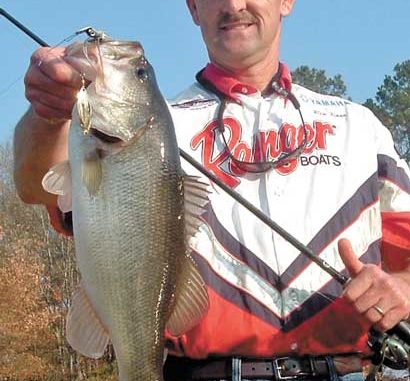
What is the most important factor in being able to make fish bite?Each day I’m leaning more toward wind.
Water temperatures and colors and time of the year are important keys in figuring out where fish will hold or feed. But wind helps put them in the boat.
How do you trick bass into biting a lure? The key to all the past “glory days” for me has been wind. Once you make an educated guess where they should be, you need wind at those areas to more easily fool bass into biting a fake bait. The only time I like calm weather is when I’m sight fishing.
Wind does a few great things to increase our chances of getting our line stretched. First, it breaks up the light and images of our lures, making it harder for bass to inspect them closely before biting.
Secondly, the wind masks noise and movement, making fish less spooky. When it’s calm, every little noise is transmitted to the water. The trolling motor is the biggest source; even quiet ones put fish on alert.
Thirdly, and possibly most important, the wind stirs up the whole ecosystem and positions bass and baitfish. In short, it gives bass a feeding advantage.
Wind forces baitfish and zooplankton to seek shelter or become disoriented. It can form mud lines and current spots that create feeding opportunities for bass.
If a strong wind causes a mud line across a point, it creates an ambush spot for bass. If that mud line happens to intersect a piece of cover or drop, watch out: you’re gonna get bit.
Many times in the past, I thought of the wind as being an advantage for power fishing with big baits moving fast. It certainly is an advantage for that, but I’ve found at least a little wind is better for all fishing, even with the tiniest of finesse baits.
Stay on the windy side
Whenever and wherever I go fishing, I always try to stay on the windy side, with exceptions being the spawn or dangerous conditions. Six-footers at Lake Erie? No thanks; I think I’ll fish in some calm water.
Even during relatively calm days, the wind often will pick up at some areas during the day, even if just for a few minutes. If an angler is concentrating at one general area during a calm day and sees a little ripple blowing into a cove, immediately check it out. A little wind is almost like schooling fish for me; if I see it, I run over there and check it out.
Many times you can pick up an extra fish during a tough day or load the boat during one of those small windows of opportunity that often determine your fate.
Seasons don’t matter
Time of the year is irrelevant with the wind.
I’ve found wind helps the bite every time of the year. Water clarity? That too doesn’t seem to matter; but wind helps.
You might have to find just the right amount of wind, but the wind will help the bite. Even with topwater lures, a little breeze really seems to make the fish make mistakes.
What to throw
If the water is muddy and the wind is blowing, nothing puts out flash like a flat-sided crankbait.
The intermittent flash broken up by wind and mud is easy for bass to find and easily one of my top choices. One of my favorite such crankbaits is handmade by Richard Angel, a North Carolina lure maker.
I like its square bill for muddy water and the fingernail bill for clearer or cold water. Team this bait with a 7-foot Daiwa Steez Flex-lite rod and Steez 6.3:1 reel and you’re in business.
Another good rod choice is the “green handle” Team Daiwa TDS graphite composite rod. These rods have just the right flex to handle these relatively light baits and keep the bass hooked.
I normally throw these baits with 12-pound test monofilament, as they are made of balsa and fluorocarbon can affect the delicate action.
If the water is clearer, a Culprit Slinky worm rigged wacky on a weighted jighead puts lots of fish in the boat. The Slinky worm is new and has a hook tail with tassels. When rigged with a weighted wacky jig, this worm quivers on the straight side and the hook tail gently twirls down. When you shake it, it squirms like a real worm.
I throw this lure using a medium, light-action Daiwa Steez 6-foot 8-inch spinning rod with 8-pound-test fluorocarbon. A gentle breeze and clear water with a relatively clean bottom and isolated cover are the ingredients to destroy some bass on this rig.
Whenever, wherever you fish, always keep the wind on your mind and you’ll find more success.
Dustin Wilks is a 31-year-old professional bass angler and Raleigh native now living in Rocky Mount. He has qualified for the Bassmaster Classic four times and operates Fish Like a Pro Fishing Lessons (252-883-6749, www.fishlikeapro.com ). His sponsors include Costa Del Mar Sunglasses, Assassinator Spinnerbaits, Chatterbuzz, Skeeter Boats, Yamaha, Daiwa, Keelshield and Culprit.



Be the first to comment